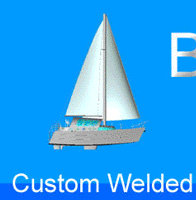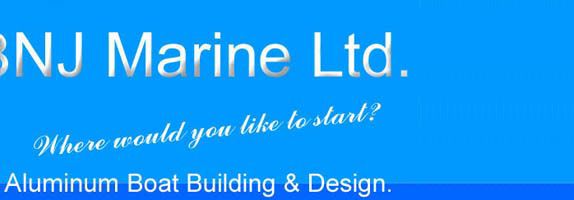Custom Aluminum Boats, Custom Boat Builders, Custom Welded Aluminum Boats, Custom Boat Building and Design


Boat Building MaterialsHere at BNJ Marine Ltd. we concentrate our efforts on Custom Welded Aluminum Boat Building. We believe that if you consider all the boat-building materials, and seek knowledge about boat building you will seriously consider building your boat of welded aluminum in preference to building with other materials. This is simply because aluminum boats have so many positive aspects that it's difficult not to make aluminum your material of choice. It is important in any discussion of boat building materials to talk a little about hull form. Any boat hull that is to be constructed from sheet material, plywood, aluminum, and steel, are for the most part restricted to developable surfaces. A developable surface can consist of flat areas, sections of cylinders, sections of cones, or a combination of flats, cylinders, and cones. Non-developable surfaces conversely are shapes that consist of compound curvature. Fibreglass boats, wood planked boats and Ferro cement boats are examples of boat building that can be done with non-developable surfaces. These non-developable surfaces are difficult to imitate in metal and are very labor intensive. From a BNJ Marine Ltd. point of view, using our advanced 3D design and an eye for fine lines we can produce very attractive hulls and outboard profiles. Using fully developable surfaces for welded-aluminum boats are indeed possible and cost effective. Though BNJ Marine Ltd. has not yet had occasion to develop a sailing mono hull. It would be our intention that very acceptable results can be achieved, either with single chine or radius chine development in aluminum.
DisclaimerIt is our purpose, below, to briefly cover some of the advantages and disadvantages of common boat building materials for your comparison. It is not our intention to offer complete information on these subjects. Each of these materials may include several building methods that are studies on their own. Custom Aluminum Boat BuildingThere are basically two main methods of building boats with aluminum, the pull up method and the jigged or frame and skin method. In the pull up method the hull is built first with all framing hand fit to the hull after the hull construction is complete. In the jigged method jigs are built before the boat is started, to control the hull and framing. BNJ Marine Ltd. has developed a third method of aluminum boat building. Using our 3D modeling advantage, we combine the best of both methods, which we like to call self-jigging. One primary advantage of aluminum is its high strength-to-weight ratio, a comparison of dead weight of the material to its mechanical properties. In simplest terms, the higher the strength-to-weight ratio of the hull material, the lighter the boat can be constructed while maintaining a given level of strength. An equivalent hull constructed from a material with a lower strength-to-weight ratio will be heavier. For a planing hull the lighter the boat the less horsepower required
and better the efficiency. In addition to lightweight and high strength, aluminum is also much more impact-resistant than steel or fibreglass. Aluminum is very ductile; it will stretch up to 12 percent before rupturing-about three times the elasticity of ship steel-in the working-stress range (tensile yield). Aluminum does not need painting. It's nearly impervious to seawater corrosion; it isn't affected by ultra-violet light; it doesn't rot or attract worms; and it doesn't rust. The time and cost savings, realized with a boat that doesn't require routine hull maintenance to protect it from the environment, are significant. It is very easy for the novice to inspect and see good welding practice and that the material is consistent. BNJ Marine Ltd. is happy to offer prototype designs in any of the fine boat building materials, however we only offer building services in aluminum. Click for important information on aluminum building issues,Galvanic corrosion 2, 3, 4, 5. Custom Ferro Cement Boat BuildingFerro cement is a technical term, not to be confused with ordinary reinforced concrete. It might be defined as a composite material consisting of a mix made from hydraulic cement mortar and a number of layers of continuous steel mesh reinforcement distributed throughout the mix. Disadvantages: its weight and poor impact resistance. Advantage: possibility of building non-developable surfaces and one of the cheapest and easiest forms of construction available to the amateur builder. Custom Fibreglass Boat BuildingPolyester resin, vinyl esters and epoxy resin and other composites. In the marine industry, liquid plastics, namely epoxies, polyesters, and vinyl esters are used to saturate (wet out) the fibres of wood, glass, Kevlar, or carbon to form a fibre reinforced plastic (FRP). There are many methods of fibreglass lay up, c-flex, single skin,
or sandwich. See disclaimer above. Vinyl ester resins are stronger than polyester resins and cheaper than epoxy resins. Vinyl ester resins utilize a polyester resin type of cross-linking molecules in the bonding process. Vinyl ester is a hybrid form of polyester resin, which has been toughened with epoxy molecules within the main molecular structure. Polyester resin is the cheapest resin available in the marine industry and offers the poorest adhesion, has the highest water absorption, highest shrinkage, and high VOC's. Polyester resin is only compatible with fibreglass fibres and is best suited to building things that are not weight sensitive. Disadvantage: deterioration in sunlight, are subject to cracking and chipping damage and very expensive moulds are required thus, reducing custom build possibilities. It is very difficult for the novice to tell good lay up practice from bad. See article (click). Advantage: complicated non-developable surfaces are possible. Custom Steel Boat BuildingSteel is an excellent boat building material, proven in use worldwide. Steel also requires developable surfaces when boat building. Disadvantage: weight, added build consideration for rust prevention,
and special tools required for cutting and shaping. Custom Wood Boat Building Wooden boat building is a large subject. For our purpose we will
break it down to sheet material or plank material. Sheet material,
like aluminum and steel, has the requirement of working with developable
surfaces. Also of note is that modern wood boat building has muddied a little,
it is some times hard to distinguish what is a wooden boat and what
is a fibreglass boat. This is because of the use of epoxy resin
in most wooden boat building today. Disadvantage: increased maintenance required keeping finished boat
in good shape, possibility of rot. Use of epoxy resin during construction
will increase cost but will reduce possibility of rot considerably. Advantages: plank (carvel, lap strake, strip planking) very nice
complex shapes are possible. Amateur builders requiring considerable
skill levels can do wooden boat building. Thank you, Perry Baskier, President
|
|
Home
| The BNJ Marine Way | Power
Boat Design |Sail Boat
Design
|
Small Boat Design
|Boat
Building Materials |BNJ
Marine Associate Boat Builders
|FAQ
| Boat Resources | Employment
| Contact | Site
Map
All Contents ©2016 BNJ
Marine Ltd. All Rights Reserved.